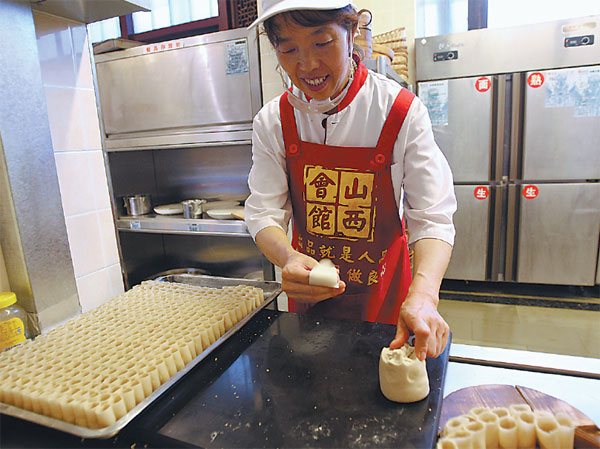Starch power
Updated: 2015-08-17 07:33
By Yang Feiyue(China Daily USA)
|
||||||||
Noodles are mealtime stars in Shanxi province. Yang Feiyue explores the food and the fun that goes with it in Taiyuan.
Missing out on local noodles in Shanxi is like skipping the Great Wall when traveling in Beijing.
When Marco Polo took noodle recipes back to Europe after visiting Shanxi in the 13th century, could he have expected that Italy's macaroni was destined to enjoy global popularity?
Noodle-making stunts in Shanxi Guild Hall restaurant give visitors a quick insight into what Shanxi locals can do with flour.
A chef dances like a gymnast with a ribbon of noodle, which elongates as he swings it around. "The movement will ensure a uniform texture," one of our hosts tells us.
Another guy, riding a unicycle, uses a knife to effortlessly shave off pieces of a dough ball that sits on his head, and pitches them toward a boiling pot.
Dough made from 2 kilograms of flour can be pulled into a single noodle that runs 100 meters, symbolizing longevity. The noodle resembles a flying dragon as it's tossed.
The dragon's-whisker noodle is a treat for the eyes: A hunk of dough can be turned into myriad hair-thin noodles in just a few seconds. The noodle is so thin that it can only be boiled briefly; then it's usually roasted with smashed sweet beans.
The diverse shapes are not just for show but for different chewing experiences, says Li Kun, service supervisor of the restaurant.
The knife-shaved noodle is relatively hard and chewy - especially popular among young people, she notes.
"The tijian (noodle bits scraped from a dough ball) resembles tiny fish and is softer than the knife-shaved noodle, so it's an ideal choice for the elderly."
Approximately 3,000 years of noodle history has enabled Shanxi people to develop their own system when it comes to eating noodles.
Local vinegar is an essential ingredient. Shanxi's geography, climate and soil are ideal for producing grains used in brewing vinegar. The smoky and sweet dark-brown liquid, known as "mature vinegar", is considered by many to be the best in China.
Made largely from sorghum, barley and peas, Shanxi vinegar is more full-bodied and well-rounded than regular distilled vinegar and is comparable to the most expensive balsamic vinegar from Italy, says Martin Yan, a Chinese-American celebrity chef based in California.
Sauces featuring tomato and fried eggs, or minced meat and chopped garlic sprouts, are commonly served with Shanxi noodles. Eggplants and Chinese cabbages are also frequently used in preparing sauce.
Pickled garlic and white and red carrots will be served alongside to balance the glutinousness and slight greasiness of the noodles, Li explains.
There are more than 400 kinds of flour that can be turned into noodles in various forms. The most common are made of buckwheat, oats, sorghum, corns and beans.
In addition to noodles, the new Shanxi cuisine has also evolved with time: It has shaken off its former dark appearance in favor of a more elegant look, says Li.
The kaolaolao is a good example: The hand-kneaded bun is sometimes carefully laid beside the minced meat and vegetable mixture used for stuffing to make an attractive plate. The sauteed version is chewy and mixed with fried eggs and vegetables. An alternate preparation comes in a bamboo steamer and resembles a beehive: Each piece is rolled into a column shape and stood up next to the others. Compared to the sauteed type, it's softer and creamier and pairs well with the tomato or fried-meat sauce. All three forms of kaolaolao should be eaten while hot. Otherwise, they will get hard and dry.
The key in preparing Shanxi food is controlling the vinegars, Li says. "The ultimate goal is to keep the vinegar fragrance and get rid the sourness."
The common practice is to pour the vinegar on the side of a pot when the food is almost ready. The high temperature will then make the vinegar evaporate, she explains.

The restaurant's cold dish, bone-free chicken feet, was a nice appetizer, a clear demonstration of tasting the fragrance of vinegar without the sourness.
An intriguing surprise: the big basket of lotus-leaf chicken wrapped in a bread crust. A waiter cuts open the bread layer and puts it aside, then rips open the lotus-leaf layer and knifes into the chicken. Four chunks of pig's feet were put in to complement the dish's taste and herald good fortune in life.
The chicken was marinated in soy sauce with garlic and ginger overnight before being roasted for 2 1/2 hours, and the result was so tender it practically melted in the mouth. The dish is presented in a big portion, reflecting Shanxi people's generosity.
High-pitched Shanxi folk songs, Peking Opera and a fire show performance are combined in an evening show on the first floor of the restaurant, which accommodates about 500 people. The second floor offers private rooms for six to 20 people, where diners can watch the performance on TV.
Contact the writer at yangfeiyue@chinadaily.com.cn
Sun Ruisheng contributed to this story.
|
From left to right: Big carp with pancakes; sauteed kaolaolao with scrambled eggs; lotus-leaf chicken wrapped in bread crust. |
|
A chef from Shanxi Guild Hall restaurant makes the hand-kneaded kaolaolao, a popular dish in Shanxi province.Photos By Zhang Wei / China Daily |
(China Daily USA 08/17/2015 page8)

 In pictures: Life near Tianjin blasts site
In pictures: Life near Tianjin blasts site
 The world in photos: Aug 10-16
The world in photos: Aug 10-16
 In the face of chaos, people persevere
In the face of chaos, people persevere
 Top 10 most expensive office markets in the world
Top 10 most expensive office markets in the world
 Times Square 'Kiss-In'
Times Square 'Kiss-In'
 School turns into place of shelter in Tianjin
School turns into place of shelter in Tianjin
 Earliest site of coal fuel found in Xinjiang
Earliest site of coal fuel found in Xinjiang
 Top 10 Chinese cities with highest property prices
Top 10 Chinese cities with highest property prices
Most Viewed
Editor's Picks

|

|

|

|

|

|
Today's Top News
Sodium cyanide in Tianjin to be collected, neutralized
Premier Li pledges thorough investigation into deadly blasts
Experts say J-10s would benefit Iran
Indonesia rescuers head to mountains in missing plane search
New York event marks war anniversary
Li, 24, runs for House
China, US engage in human rights
China investigates Tianjin blasts, experts focus on chemicals
US Weekly

|

|






